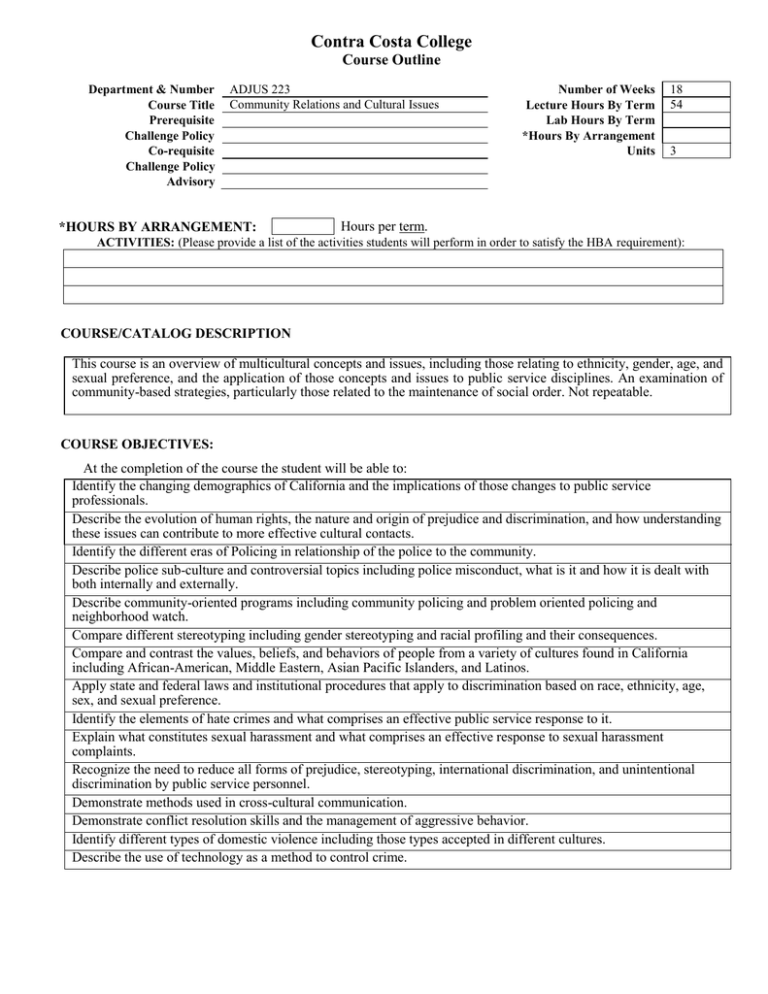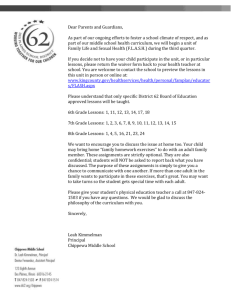
Contra Costa College
Course Outline
Department & Number
Course Title
Prerequisite
Challenge Policy
Co-requisite
Challenge Policy
Advisory
ADJUS 223
Community Relations and Cultural Issues
*HOURS BY ARRANGEMENT:
Number of Weeks
Lecture Hours By Term
Lab Hours By Term
*Hours By Arrangement
Units
18
54
3
Hours per term.
ACTIVITIES: (Please provide a list of the activities students will perform in order to satisfy the HBA requirement):
COURSE/CATALOG DESCRIPTION
This course is an overview of multicultural concepts and issues, including those relating to ethnicity, gender, age, and
sexual preference, and the application of those concepts and issues to public service disciplines. An examination of
community-based strategies, particularly those related to the maintenance of social order. Not repeatable.
COURSE OBJECTIVES:
At the completion of the course the student will be able to:
Identify the changing demographics of California and the implications of those changes to public service
professionals.
Describe the evolution of human rights, the nature and origin of prejudice and discrimination, and how understanding
these issues can contribute to more effective cultural contacts.
Identify the different eras of Policing in relationship of the police to the community.
Describe police sub-culture and controversial topics including police misconduct, what is it and how it is dealt with
both internally and externally.
Describe community-oriented programs including community policing and problem oriented policing and
neighborhood watch.
Compare different stereotyping including gender stereotyping and racial profiling and their consequences.
Compare and contrast the values, beliefs, and behaviors of people from a variety of cultures found in California
including African-American, Middle Eastern, Asian Pacific Islanders, and Latinos.
Apply state and federal laws and institutional procedures that apply to discrimination based on race, ethnicity, age,
sex, and sexual preference.
Identify the elements of hate crimes and what comprises an effective public service response to it.
Explain what constitutes sexual harassment and what comprises an effective response to sexual harassment
complaints.
Recognize the need to reduce all forms of prejudice, stereotyping, international discrimination, and unintentional
discrimination by public service personnel.
Demonstrate methods used in cross-cultural communication.
Demonstrate conflict resolution skills and the management of aggressive behavior.
Identify different types of domestic violence including those types accepted in different cultures.
Describe the use of technology as a method to control crime.
STUDENT LEARNING OUTCOMES:
Intended Outcome
Assessment Method
Assessment Criteria
Analyze case studies and
develop community centered
crime suppression methods.
Explain how culture impacts
policing strategies in modern
American Society.
Group presentation regarding crime
suppression interventions.
Students will score at least 75% on a shared
presentation assessment rubric.
Conduct research involving immigration
trends and create a report.
75% of the students will score at least 75%
on a shared report assessment rubric.
Apply ethical decision making
to enforcement actions.
Embedded exam questions.
70% of the students will answer the
embedded questions correctly.
Identify special population
crimes.
Embedded exam questions.
70% of the students will answer the
embedded questions correctly.
COURSE CONTENT (Lecture):
Public service employees and the community
Community and problem oriented policing
Cultural make-up of California
Police subculture and misconduct
Perceptions as they are affected by culture
Threats to human rights
Strategies for effective contacts
Sexual harassment
Principle of effective communications
Communicating to resolve conflict
Hate crimes
COURSE CONTENT (Lab):
METHODS OF INSTRUCTION:
Lecture (live and online)
Online Discussions
Research and writing assignments
Group exercises and presentations
D2L Learning management software
INSTRUCTIONAL MATERIALS:
NOTE: To be UC/CSU transferable, the text must be dated within the last 7 years OR a statement of justification for a text beyond the
last 7 years must be included.
Textbook Title:
Author:
Publisher:
Edition/Date:
Textbook Reading Level:
Justification Statement:
Police Crime Control Strategies
Larry Hoover
Pearson-Prentice Hall
2014
13
OUTSIDE OF CLASS WEEKLY ASSIGNMENTS:
Title 5, section 55002.5 establishes that a range of 48 -54hours of lecture, study, or lab work is required for one unit of credit.
For each hour of lecture, students should be required to spend an additional two hours of study outside of class to earn one
unit of credit.
State mandates that sample assignments must be included on the Course Outline of Record.
Outside of Class Weekly Assignments
Hours per week
Weekly Reading Assignments (Include detailed assignment below, if applicable)
2
The student will read weekly textbook assignments as well as an online reader
Weekly Writing Assignments (Include detailed assignment below, if applicable)
1
The students will write a 12 page research paper using 8 references in APA format. This assignment will provide a
mandatory rewrite based on instructor feedback.
Weekly Math Problems (Include detailed assignment below, if applicable)
Lab or Software Application Assignments (Include detailed assignment below, if applicable)
1
The student will participate in weekly discussions where they conduct research to critically analyze and critique the
topics assigned and respond appropriately to class postings.
Other Performance Assignments (Include detailed assignment below, if applicable)
2
Group learning exercises and group research project
STUDENT EVALUATION: (Show percentage breakdown for evaluation instruments)
30
40
30
Exams
Group Exercises
Research projects
%
%
%
%
GRADING POLICY: (Choose LG, P/NP, or SC)
Pass / No Pass
x Letter Grade
90% - 100% = A
80% - 89% = B
70% - 79% = C
60% - 69% = D
Below 60% = F
Prepared by: R. Ramos
Date: 11/27/14
Revised form 10/13
70% and above = Pass
Below 70% = No Pass
Student Choice
90% - 100% = A
80% - 89% = B
70% - 79% = C
60% - 69% = D
Below 60% = F
or
70% and above = Pass
Below 70% = No Pass



